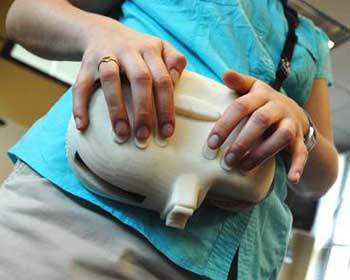A device that started out as a university project could make the lives of millions of visually impaired people easier.
One everyday problem for people who are blind or have very limited sight is distinguishing things that are completely identical to the sense of touch, such as different CDs and DVDs, or canned goods that are all the same size and shape. To cope with that difficulty, many people make Braille labels to attach to these items.
But the existing devices for doing this are either expensive and heavy - one device costs about $650 (£400) and has limited portability - or light and inexpensive but very difficult for a blind person to operate, and limited in the number of characters they can imprint.
A team of MIT students searching for a better solution have now developed a new prototype device that is small and easily portable, can produce the entire panoply of possible Braille characters (including commonly used two-character contractions), and can be relatively easily loaded and operated by touch.
Although it is still under development, they hope the device, which they have named the 6dot Braille Labeler, can ultimately be produced for sale at around $200.
The battery-operated device uses standard Dymo label tape, and has a built-in microprocessor that can store up to 16 characters in case the user types faster than the device can emboss the tape. It has six buttons across the top - one for each of the six dots in that make up a Braille character - that can be operated by placing two hands on the unit's top, very much like touch typing. The device makes sounds as it embosses each character, providing some auditory feedback to confirm that it's working.
When the label is finished, the user activates a built-in blade to cut the label off. Ultimately, the developers plan to add another blade that will score the end of the tape to make it easier to peel off the backing, but that has proved more difficult to achieve than they had anticipated.
Karina Pikhart, one of the students that developed the device, said that she is now looking for a manufacturer interested in licensing the design.

Karina Pikhart displays the Braille label maker she and her team-mates designed




April 1886: the Brunkebergs tunnel
First ever example of a ground source heat pump?